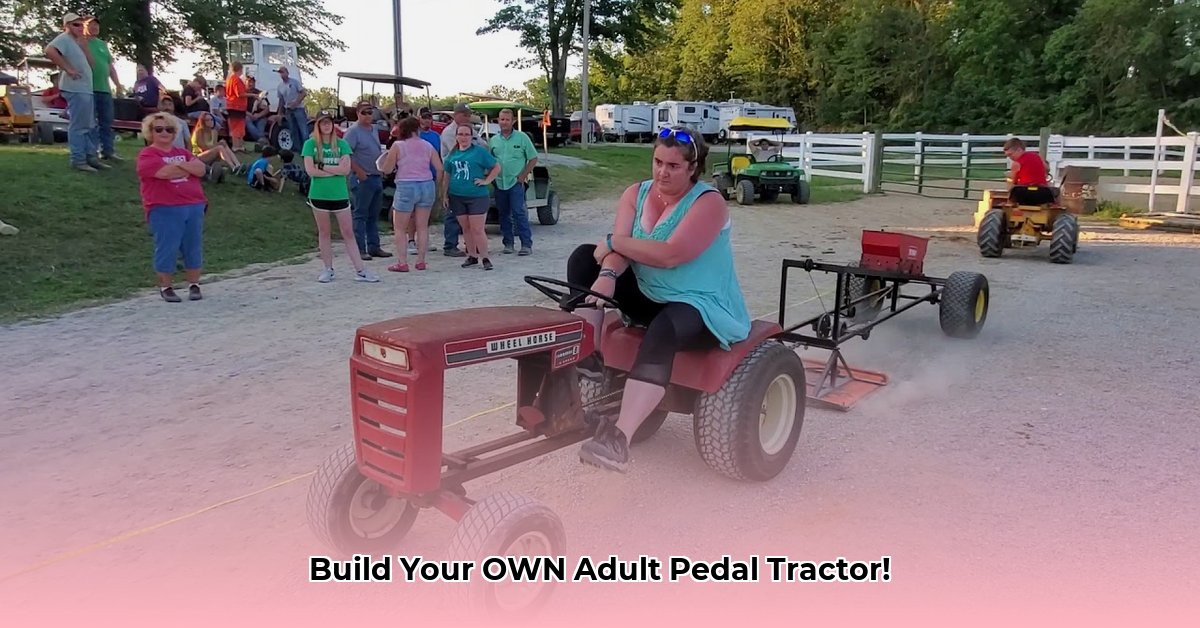
Ever dreamed of reliving childhood joy with an adult-sized pedal tractor? This comprehensive guide empowers you to build or modify your own, transforming a simple toy into a customizable ride. From choosing the right base to adding a motor and brakes, we'll cover every step, ensuring safety and legal compliance throughout. Let's get started! For inspiration, check out this Murray Pedal Tractor example.
1. Choosing Your Foundation: Kid's Tractor or Building from Scratch?
Your first decision: starting with a child's pedal tractor or building from the ground up. A used children's tractor is a cost-effective option, providing a ready-made frame. However, substantial modifications will be necessary. Building from scratch offers complete design freedom but requires advanced welding and fabrication skills and a significantly higher budget.
| Option | Advantages | Disadvantages | Estimated Cost |
|---|---|---|---|
| Used Child's Tractor | Relatively inexpensive, readily available, provides a basic frame to modify | Requires extensive modification, may not be sturdy enough for an adult's weight | $50 - $200 |
| Building from Scratch | Complete customization, potentially stronger build, tailored to your needs | Requires advanced welding/fabrication skills, much more expensive & time-consuming | $500 - $1500+ |
Consider your budget, DIY skills, and desired level of customization. For beginners, a used child's tractor is a more approachable starting point. But, are you up for the challenge of building from scratch for ultimate customization?
2. Essential Modifications: Safety First!
This section details key modifications, prioritizing safety. Remember: incorrect modifications can be dangerous. If you're unsure about any step, seek professional help.
- Strengthening the Frame: An adult's weight requires a reinforced frame. Welding, bracing, or using thicker tubing is likely necessary. Are you confident in your welding skills, or should you seek professional help?
- Adult-Sized Seating: Replace the child-sized seat with a comfortable, secure adult seat. Consider ergonomics and long-term comfort. What kind of material would provide the best combination of comfort and durability?
- Reliable Braking System: A powerful braking system is crucial. Disc brakes or a significantly upgraded coaster brake are recommended for safe stops. What braking system will provide the most responsive and reliable stopping power for increased safety?
- Motorization (Optional): Adding an electric motor boosts capabilities. Check local regulations before installation. Smaller motors might simply assist pedaling, potentially avoiding stricter legal requirements. How powerful a motor can you legally install in your area?
- Adequate Lighting: Install front and rear lights meeting local regulations for nighttime visibility. What type of lights offer the best visibility and durability for your needs?
3. Sourcing Your Parts: Finding the Right Components
Finding the right parts requires resourcefulness. Online retailers (eBay, Amazon), local hardware stores, and salvage yards are all potential sources. Always compare prices and inspect parts for quality before purchase. Finding specialized parts may require contacting agricultural equipment or automotive parts suppliers. What's your strategy for sourcing all the parts you need?
4. Legal Compliance: Understanding Local Regulations
Before your first ride, research local laws regarding motorized vehicles. Regulations vary widely. Your tractor's classification (low-speed vehicle, modified bicycle, etc.) impacts the rules you must follow.
Checklist:
- Motor Size Limit: What's the legal limit for motor power (watts or horsepower)?
- Lighting Requirements: What lights are legally required?
- Brake System Standards: Does your braking system meet legal requirements?
- Registration/Licensing: Is registration or licensing required?
Contact your local Department of Motor Vehicles (or equivalent) for clarification if needed. Is there a specific agency you should contact in your region to confirm legal requirements?
5. Maintenance and Repair: Keeping Your Tractor Running
Regular maintenance prolongs your tractor's life and ensures safety. Lubricate moving parts, inspect brakes, and check the frame for wear and tear. Maintaining detailed records will assist in troubleshooting and future repairs. What's your preventative maintenance plan to keep your tractor in top condition?
6. Community and Resources: Connecting with Fellow Enthusiasts
Online forums and communities dedicated to pedal tractors, DIY projects, or custom vehicle builds provide invaluable support, troubleshooting, inspiration, and camaraderie. What specific online resources are readily available for sharing your projects and seeking help?
Building your adult pedal tractor is a rewarding blend of engineering, creativity, and fun. Careful planning, precise execution, and an unwavering focus on safety are key to success. Now, get building!